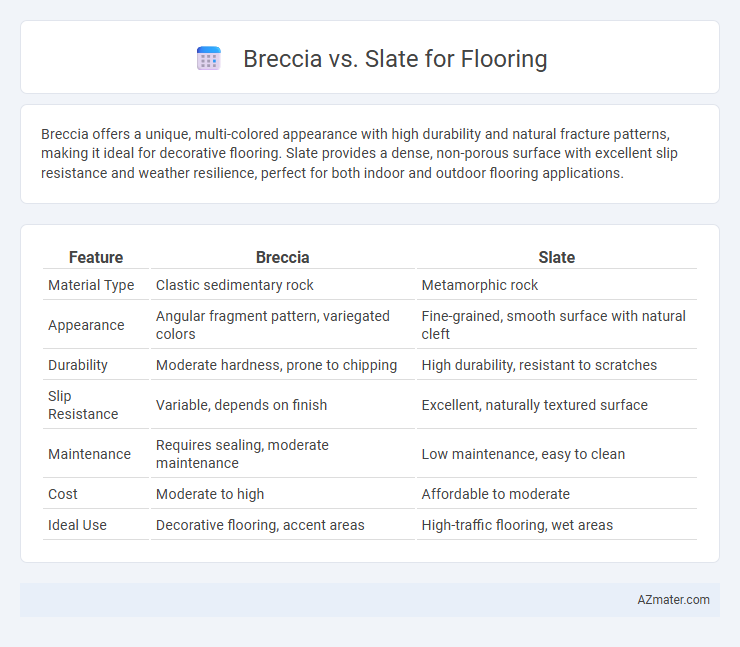Breccia offers a unique, multi-colored appearance with high durability and natural fracture patterns, making it ideal for decorative flooring. Slate provides a dense, non-porous surface with excellent slip resistance and weather resilience, perfect for both indoor and outdoor flooring applications.
Table of Comparison
| Feature | Breccia | Slate |
|---|---|---|
| Material Type | Clastic sedimentary rock | Metamorphic rock |
| Appearance | Angular fragment pattern, variegated colors | Fine-grained, smooth surface with natural cleft |
| Durability | Moderate hardness, prone to chipping | High durability, resistant to scratches |
| Slip Resistance | Variable, depends on finish | Excellent, naturally textured surface |
| Maintenance | Requires sealing, moderate maintenance | Low maintenance, easy to clean |
| Cost | Moderate to high | Affordable to moderate |
| Ideal Use | Decorative flooring, accent areas | High-traffic flooring, wet areas |
Introduction to Breccia and Slate Flooring
Breccia flooring features a unique, natural stone composition characterized by angular fragments cemented together, providing a striking, textured appearance ideal for creating focal points in interior design. Slate flooring, derived from fine-grained metamorphic rock, offers durability and a smooth, layered surface with natural cleft textures that enhance slip resistance and add rustic elegance to spaces. Both materials are prized for their longevity and distinctive aesthetic qualities, making them popular choices in residential and commercial flooring applications.
Key Characteristics of Breccia Flooring
Breccia flooring is characterized by its unique composition of angular rock fragments bound by a fine-grained matrix, offering a bold and dynamic appearance with natural veining and varied coloration. Its durability and resistance to wear make it suitable for high-traffic areas, while its polished surface provides a sophisticated, glossy finish enhancing interior aesthetics. Unlike slate, Breccia's heterogeneous texture and vibrant patterns create a distinctive visual impact, making it a preferred choice for designers seeking a statement flooring option.
Essential Properties of Slate Flooring
Slate flooring offers exceptional durability, natural slip resistance, and a unique, textured appearance with rich variations in color and pattern. Its dense, fine-grained metamorphic composition provides resistance to moisture, stains, and wear, making it ideal for high-traffic areas and wet environments. Compared to breccia, slate requires less maintenance and boasts superior hardness, ensuring long-lasting performance and aesthetic appeal in diverse interior and exterior applications.
Aesthetic Differences: Breccia vs Slate
Breccia flooring showcases a dramatic, fragmented pattern with vibrant colors and irregular angular pieces, creating a bold, eye-catching aesthetic ideal for statement spaces. Slate flooring offers a more subdued, natural look characterized by fine-grained, layered textures and muted earthy tones, providing a rustic yet elegant appeal. The dynamic contrast between Breccia's chaotic mosaic and Slate's uniform, matte finish defines their distinct visual identities in interior design.
Durability and Longevity Comparison
Breccia flooring offers superior durability due to its composition of angular rock fragments cemented together, making it highly resistant to cracking and wear in high-traffic areas. Slate, a fine-grained metamorphic stone, provides exceptional longevity with natural cleft surfaces that resist scratches, though it may require sealing to prevent moisture damage. Both materials endure well over time, but Breccia's hardness generally outperforms Slate in heavy-use durability.
Installation Considerations for Each Material
Breccia requires precise cutting and sealing techniques during installation due to its varied mineral composition and irregular patterns, ensuring durability and aesthetic appeal. Slate flooring demands careful surface preparation and a moisture-resistant underlayment to prevent cracking, as well as professional grouting to handle its natural cleft texture. Both materials benefit from skilled labor to maintain their unique characteristics and maximize longevity in high-traffic areas.
Maintenance Requirements: Breccia vs Slate
Breccia flooring requires regular sealing to maintain its durability and prevent staining due to its porous nature, whereas slate demands frequent cleaning and occasional resealing to preserve its natural slip resistance and rich texture. Both materials benefit from using pH-neutral cleaners to avoid surface damage, but slate's layered composition can be more prone to chipping if not properly maintained. Choosing between breccia and slate hinges on balancing the level of upkeep with aesthetic preferences and the specific environment of the installation.
Cost Analysis and Budget Factors
Breccia flooring typically incurs higher upfront costs due to its unique, natural stone appearance and complex extraction process, making it a premium option compared to slate. Slate offers a more budget-friendly choice with lower material and installation expenses, while still providing durability and aesthetic appeal. Cost analysis should factor in long-term maintenance, with breccia potentially requiring specialized care that could increase overall expenditure.
Best Applications for Breccia and Slate Flooring
Breccia flooring is best suited for high-traffic areas such as commercial spaces and entryways due to its durable, multi-colored stone composition that effectively conceals dirt and wear. Slate flooring excels in residential settings like kitchens and bathrooms because of its natural slip resistance, water durability, and elegant, textured surface. Both stones offer unique aesthetic appeal, with Breccia providing vibrant, mosaic patterns and Slate delivering a classic, earthy look ideal for rustic or contemporary interiors.
Choosing the Right Stone: Breccia or Slate?
Breccia offers a unique, multicolored pattern with a polished finish, making it ideal for luxurious flooring that highlights natural stone artistry. Slate provides a durable, slip-resistant surface with a textured, matte appearance perfect for high-traffic areas and rustic interiors. Selecting between Breccia or Slate depends on desired aesthetics, durability needs, and maintenance preferences, with Breccia excelling in elegance and Slate in practicality.

Infographic: Breccia vs Slate for Flooring
 azmater.com
azmater.com